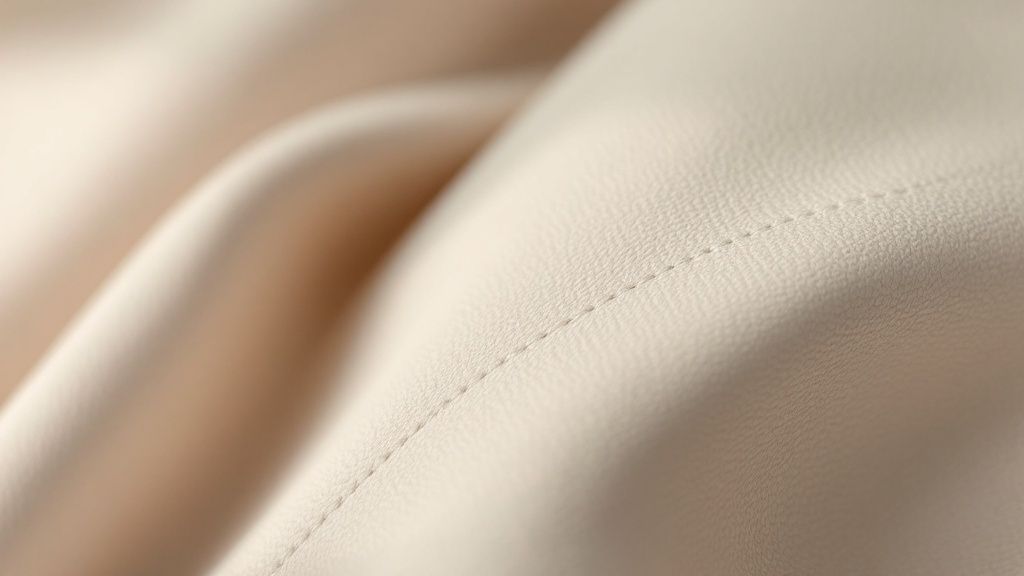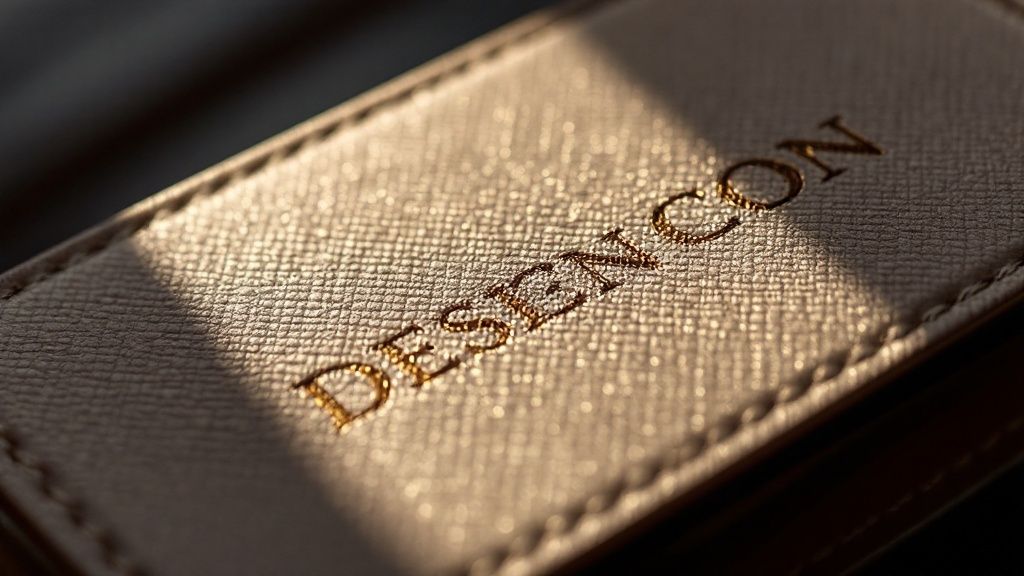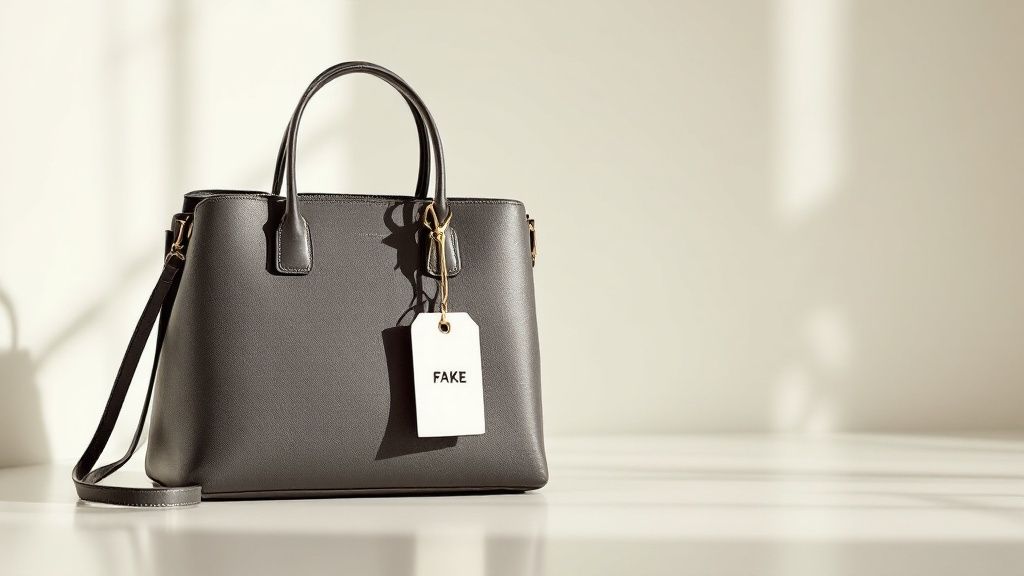The High-Stakes World of Luxury Counterfeits
The world of luxury handbags is unfortunately plagued by a thriving counterfeit industry. What was once a trade in easily identifiable knockoffs has evolved into the creation of incredibly deceptive "superfakes"—replicas so convincing they can fool even the most experienced collectors. This makes understanding how to spot a fake designer bag more critical than ever. The line between real and fake has blurred, demanding a discerning eye and a deeper knowledge of the market.
The Growing Counterfeit Market
This illicit industry thrives on deception, using psychological tricks to convince buyers of a bag's authenticity. Counterfeiters exploit the desire for luxury goods, often offering deals that seem too good to be true. Recognizing these tactics is the first line of defense. The sheer size of the counterfeit market is truly alarming. Designer handbags, a frequent target, contribute to a staggering $2.8 trillion loss in global trade due to counterfeit and pirated goods, representing roughly 3.3% of international trade. Find more detailed statistics here The rise of online platforms has further complicated the issue, giving counterfeiters new ways to reach unsuspecting buyers. In 2022 alone, U.S. Customs and Border Protection seized $972.5 million worth of counterfeit handbags and wallets. Protecting your investment in designer bags means making smart choices, especially when traveling. Check out the features of a perfect handbag for travel inspiration.

The Allure of "Superfakes"
The increasing sophistication of superfakes poses a significant threat. These high-quality replicas mimic authentic bags with incredible precision, making visual inspection alone unreliable. Counterfeiters meticulously reproduce even the smallest details, like stitching, hardware, and logos. This requires developing more advanced authentication skills that go beyond surface observations. It means understanding the nuances of materials, construction techniques, and brand-specific security features.
Why Authentication Matters
Honing your authentication skills is no longer a niche hobby for collectors; it's a necessity for anyone investing in luxury accessories. Beyond the financial implications, authenticating your purchase supports ethical business practices. It protects the reputation of luxury brands and the livelihoods of the skilled artisans who craft these coveted items. Knowing how to spot fake designer bags helps preserve the integrity of the luxury market and ensures your investment is genuine.
Beyond Your Wallet: The Real Cost of Fake Bags

The allure of a designer handbag is undeniable. Who doesn't dream of owning a classic piece of Chanel or Gucci? But the counterfeit market casts a long shadow over this desire, creating a hidden economy with consequences that ripple far beyond the luxury industry. Buying a fake bag isn't just a personal choice; it fuels a system with significant ethical and economic ramifications.
The Economic Impact of Counterfeiting
The counterfeit bag trade operates on a massive scale. It undermines legitimate businesses, impacting jobs and stifling innovation within the fashion industry. Profits lost to counterfeiters represent money that could have been reinvested in research and development, or used to support skilled artisans.
This loss has a cascading effect, impacting everyone from the designers themselves to the factory workers who bring their visions to life. The sheer scale of the counterfeit handbag trade is startling when compared to actual national economies.
In 2019, the global trade in counterfeit goods was estimated at $449 billion. To put that in perspective, the GDP of Ireland in the same year was approximately $431 billion. This stark comparison underscores the substantial economic impact of counterfeiting, not just on luxury brands, but on entire national economies. Find more detailed statistics here Understanding consumer behavior and the allure of luxury goods is key to grasping the risks of counterfeiting. Learn more about luxury fashion and its influence.
The Human Cost of Fake Bags
Beyond the economic consequences, there's a human cost to consider. Counterfeit operations often involve exploitative labor practices, characterized by unsafe working conditions and unfair wages. Furthermore, the profits generated from these illegal activities frequently flow into organized crime. This means that purchasing a counterfeit bag could be indirectly supporting these harmful practices.
Protecting Artistry and Tradition
Luxury designer bags are more than just a fashion accessory; they represent a culmination of artistry and tradition. The meticulous craftsmanship and attention to detail poured into creating an authentic designer bag are often absent in counterfeits.
By supporting the counterfeit market, you devalue the skills of these artisans and erode the rich heritage of the luxury industry. Choosing authentic products, on the other hand, helps preserve this unique blend of artistry and tradition. Ultimately, understanding how to spot a fake empowers you to make informed purchasing decisions that reflect your values. It's about recognizing the broader implications of your choices and supporting ethical practices within the fashion world.
The Telltale Touch: Mastering Material Authentication

Authenticating a designer bag involves more than just checking the logo. It requires developing a discerning touch, a true understanding of luxury materials. This becomes your greatest asset in distinguishing genuine pieces from increasingly sophisticated counterfeits.
Feeling the Difference: Genuine Leather vs. Imitations
Understanding the nuances of leather is the first step in material authentication. Authentic designer bags use high-quality hides with unique characteristics. Genuine leather has a distinctive suppleness and a subtle, natural grain. Counterfeiters often struggle to replicate this.
Running your hand across real leather reveals a slight texture and a soft, almost buttery feel. Counterfeit bags typically use coated or synthetic materials. These often feel stiff, plasticky, or excessively smooth. This tactile difference is a key initial indicator.
The Language of Stitching and Hardware
The construction of the bag, beyond the leather itself, reveals much about its authenticity. Examine the stitching closely. Authentic designer bags feature meticulous, even stitching, often done by hand.
The thread should be consistent in color and tension, with no loose ends or uneven lines. The hardware – zippers, buckles, chains – also plays a crucial role. Authentic hardware feels substantial and well-crafted, with a consistent finish. Counterfeiters often compromise on hardware quality, resulting in lightweight, hollow pieces that might chip or tarnish easily.
To help you discern between authentic and counterfeit materials, take a look at the comparison table below. It summarizes some of the key differences to keep in mind.
Authentic vs. Counterfeit Material Characteristics:
This table compares the key material differences between authentic and counterfeit bags to help shoppers identify fakes.
| Material Feature | Authentic Designer Bags | Common Counterfeit Indicators |
|---|---|---|
| Leather | Supple, natural grain, distinct smell | Stiff, plasticky feel, uniform texture, chemical smell |
| Stitching | Precise, even, consistent tension | Uneven, loose threads, inconsistent color |
| Hardware | Substantial weight, consistent finish, smooth operation | Lightweight, hollow feel, chipping or tarnishing, rough edges |
| Interior Lining | High-quality fabric, often suede or canvas | Cheap, synthetic material, prone to tearing or fraying |
As this table clearly shows, there are significant differences in the quality of materials used in authentic versus counterfeit bags. Paying attention to these details can help you avoid purchasing a fake.
The Patina of Time: A Collector's Secret
One often overlooked aspect of authentication is the development of patina. Authentic leather bags develop a unique sheen and subtle wear patterns over time. This patina is a testament to the bag's age and use, enhancing its character and value.
Counterfeit bags, being newer, lack this natural aging process. A pristine, “too perfect” bag can be a warning sign. By understanding how different leathers age, you gain a valuable authentication tool. Many counterfeiters can’t replicate this. This temporal dimension adds another layer of security to your investment.
Learning how to spot fake designer bags involves developing a sensory understanding of quality. By training your eye and touch to recognize the subtle details of authentic materials and craftsmanship, you can confidently navigate the luxury market and protect your investment.
Brand-Specific Security: Decoding Authentication Features

Luxury brands are in a constant battle against counterfeiters. They employ evolving security measures, meaning authentication requires a brand-specific approach. Let's explore how to confidently assess the authenticity of designer bags.
Deciphering the Codes: Serial Numbers and Date Codes
Many luxury brands, like Louis Vuitton and Chanel, use serial numbers and date codes to track their products. These codes are often tucked away inside the bag's lining or on a leather tag. They offer vital clues for authentication.
However, just finding a code isn't enough. You need to know how to interpret it. For example, Louis Vuitton date codes have changed over time. Older codes use letters and numbers to indicate the factory and production date. Newer codes use two letters followed by four numbers. Understanding these variations is key to differentiating vintage from contemporary pieces. Chanel uses serial numbers tied to specific manufacturing periods. Websites and online forums are invaluable resources for decoding these codes, enabling you to verify a bag's authenticity.
Authentication Cards: A Closer Look
Many designer bags include authentication cards. However, counterfeiters try to replicate these too. So, it's crucial to examine the card carefully. Authentic cards usually have high-quality printing, precise logos, and a unique serial number that matches the bag.
The card stock itself should feel thick and luxurious. Look for inconsistencies in the font, logo placement, or overall card quality. These subtle differences can expose a counterfeit.
The Rise of Technological Authentication: RFID and Microchips
Technology is changing the authentication game. Some brands now embed RFID tags (Radio-Frequency Identification) or microchips in their products. These technologies allow for quick and reliable verification using special scanners.
But don't assume a missing RFID tag means a bag is fake, especially with older bags. Consider the bag's age and when the brand adopted these technologies. Some brands only started using RFID technology recently. Older, authentic bags might not have them.
Spotting the Flaws: Examining Counterfeit Security Features
Counterfeiters try to copy brand-specific security features. But their attempts rarely match the precision and quality of the real thing. Closely inspect the security features for inconsistencies. A poorly copied date code, an off-center logo on the authentication card, or a flimsy RFID tag can all point to a fake. Familiarizing yourself with each brand's security features is essential.
By combining this knowledge with an understanding of materials and craftsmanship, you can confidently authenticate luxury goods across different brands and eras.
The Details That Don't Lie: Hardware and Logo Analysis
Authenticating a designer bag requires a thorough inspection of its smallest details. The quality of the hardware and the precision of the logo often reveal a bag's true origins. These seemingly minor elements can expose a counterfeit, even if the overall look is convincing.
Dissecting the Hardware: Zippers, Locks, and Chains
Start by carefully examining the bag's hardware. Authentic designer bags use high-quality metals for their zippers, locks, and chains. These pieces should have a solid, substantial weight, not feel hollow or light. Zippers should move smoothly, and locks should close securely with a distinct click.
For example, consider the chain links on a Chanel bag. Authentic chains possess a noticeable weight and a smooth, polished finish. Counterfeit chains often feel lighter and might have rough edges or uneven plating. Likewise, engraved logos on zippers and locks should be crisp and perfectly aligned. Blurring or misalignment is a major red flag.
The Weight of Authenticity: Consistent Finish and Functionality
Authentic hardware maintains a consistent finish across all pieces. The color and sheen should match perfectly, with no signs of chipping or tarnishing. This consistent quality reflects the meticulous attention to detail that defines luxury brands.
Furthermore, the hardware must be functional. A zipper that sticks or a lock that doesn't close properly suggests a counterfeit. Luxury brands prioritize both aesthetics and functionality, ensuring every element of the bag performs flawlessly. Counterfeiters often neglect functionality, focusing only on visual imitation.
Logo Logic: Font Psychology and Typographic Identity
Luxury brands fiercely protect their logos, maintaining strict control over their typographic identity, from the specific font to the kerning and spacing between letters. This attention to detail plays a crucial role in brand recognition and perceived value.
Authentic logos display precise proportions and spacing. Counterfeiters often misinterpret these subtle details, creating logos that appear slightly off. For example, the spacing between letters might be too wide or too narrow, or the font itself might be subtly different. Comparing the logo on the bag to a verified image from the brand's website can reveal discrepancies.
Placement and Stamping: Identifying Subtle Inaccuracies
The placement and stamping of the logo are also essential indicators of authenticity. Authentic logos are precisely positioned, often in specific locations dictated by the brand’s design guidelines. The stamping should be clean, even, and consistently deep.
Counterfeit logos might be placed incorrectly—too high or too low—or the stamping might be uneven or too shallow. For instance, the embossed logo on a Louis Vuitton bag should have a distinct depth and uniform appearance. A shallow or uneven embossing is a sign of a counterfeit.
To assist in your authentication journey, refer to the table below:
Hardware Authentication Checklist by Brand
A detailed breakdown of hardware features to verify when authenticating bags from major luxury brands
| Brand | Hardware Type | Authentic Characteristics | Red Flags |
|---|---|---|---|
| Chanel | Chain | Heavy, smooth, polished finish | Lightweight, rough edges, inconsistent plating |
| Louis Vuitton | Zipper Pull | Engraved logo crisp, perfectly aligned | Blurred or misaligned logo |
| Louis Vuitton | Embossed Logo | Distinct depth, uniform appearance | Shallow or uneven embossing |
| Hermès | Hardware | Palladium or gold-plated, heavy, precise engravings | Lightweight, dull finish, imprecise engravings |
| Dior | Clasp | "CD" logo perfectly formed, secure closure | Misshapen logo, loose closure |
This table highlights key characteristics to examine when authenticating hardware and logos on designer bags. By understanding these brand-specific details, you can better identify potential counterfeits.
These small details—the weight of a zipper pull, the spacing in a logo, the depth of a stamp—often provide the strongest evidence of a bag's authenticity. By developing a keen eye for these subtle cues, you can confidently distinguish between genuine designer bags and even the most sophisticated counterfeits.
Authentication in the Digital Age: Tech Tools That Work
Technology is changing the way we verify the authenticity of designer bags, giving us effective tools to combat increasingly sophisticated counterfeits. From specialized apps to AI-powered services, several options are available to help you verify authenticity.
Entrupy and Other Authentication Apps
Several apps, like Entrupy, leverage AI and machine learning to examine images of designer bags, comparing them to a vast database of authentic products. These apps can often pick up on microscopic details that the human eye might miss. Entrupy, for example, boasts a 99.1% accuracy rate in identifying counterfeit luxury goods. This technology offers an added layer of confidence when purchasing pre-owned bags online.
ProAuthenticators and LegitGrails: Remote Authentication Services
Services like ProAuthenticators and LegitGrails offer remote authentication performed by teams of experts. These services usually involve submitting detailed photographs of your bag for review by trained professionals. This approach is especially helpful for items that may lack clear security features or when in-person authentication isn't an option.
Blockchain Technology: Tracing Provenance
Emerging technologies like blockchain hold exciting potential for the future of authentication. Luxury brands are starting to incorporate blockchain provenance records, effectively creating a secure and transparent history of a bag's journey from the factory to the consumer. This technology allows for tracking ownership and combats counterfeiting by generating a tamper-proof record. Eventually, verifying a bag's authenticity may be as easy as scanning a QR code.
Capturing Optimal Photographs for Remote Verification
The quality of your photographs is essential when using remote authentication services or apps. Be sure to capture clear, well-lit images of all key details. This includes the logo, hardware, stitching, date code, and other unique identifiers. For instance, focus on capturing the embossing on the hardware, the stitching pattern, and the texture of the leather.
Interpreting Digital Authentication Reports
While technology provides valuable tools, it's important to understand how to interpret the results you receive. Authentication reports typically provide detailed explanations of their findings, including specific comments regarding the bag's materials and construction. If a report raises any potential concerns, take time to understand the reasoning behind those concerns. Combine these technological insights with your own observations. This balanced approach to authentication, blending traditional methods with digital tools, is the best defense against sophisticated fakes. Knowing when to depend solely on technology and when to supplement it with a hands-on inspection is crucial.
Safeguarding Your Investment: Where Smart Shoppers Buy
Knowing how to spot a fake designer bag is essential, but the best defense is proactive shopping. This involves understanding where to buy authentic merchandise and how to vet sellers, building a personal purchasing protocol to minimize your counterfeit risk.
Authorized Retailers: The Gold Standard
The safest way to ensure authenticity is buying directly from authorized retailers. This includes the brand's official website, flagship stores, and department stores with established partnerships. For example, buying a Chanel bag from Chanel.com or a Louis Vuitton bag from a Louis Vuitton boutique guarantees authenticity. Authorized retailers invest in supply chain security and offer strong return policies, providing peace of mind.
Reputable Resale Platforms: Navigating the Pre-Owned Market
The pre-owned market offers great deals but requires careful consideration. Choose established resale platforms with robust authentication processes. Sites like Fashionphile and The RealReal employ expert authenticators who inspect each item before listing. Even with these safeguards, it's wise to familiarize yourself with the platform's authentication guarantee and return policy.
Consignment Shops: A Local Approach
Local consignment shops can be hidden gems, but due diligence is key. Research the shop's reputation and inquire about their authentication process. Don't hesitate to ask about a bag's history and origin. Some reputable consignment stores even offer their own authentication services, adding extra assurance.
Auction Houses: High Stakes, High Rewards
Auction houses like Sotheby's and Christie's often feature rare and desirable designer bags. While they have rigorous authentication procedures, it's still wise to do your own research and inspect the bag carefully before bidding.
Red Flags: Spotting Suspicious Sellers
Beware of sellers offering prices significantly below market value. If a deal seems too good to be true, it probably is. Other red flags include:
- Stock photos: Authentic sellers use real photos of the actual bag. Stock photos are a major warning.
- Evasive communication: Sellers who avoid specific questions about a bag's authenticity or history are likely hiding something.
- High-pressure sales tactics: Phrases like "limited-time offer" or "only one left" create a false sense of urgency, pressuring you into a hasty purchase.
- Unsecure payment methods: Always use secure payment gateways with buyer protection. Avoid sellers who insist on wire transfers or other untraceable payments.
Realistic Pricing Expectations: Avoiding Counterfeit Traps
Understanding realistic pricing is crucial. Research the current market value of the bag you want. This helps you identify suspiciously low prices, a hallmark of counterfeits. Remember, authentic designer bags hold their value, so significant discounts are rare.
Creating Your Personal Purchasing Protocol: A Checklist for Smart Shopping
- Start with authorized retailers: Whenever possible, buy directly from the brand or a reputable department store.
- Vet resale platforms: Choose platforms with strong authentication and clear return policies.
- Research consignment shops: Inquire about authentication methods and ask detailed questions about the bag's history.
- Inspect before you buy: Carefully examine materials, hardware, logo, and stitching.
- Trust your gut: If something feels wrong, walk away.
By using these strategies and your authentication skills, you can confidently navigate the luxury market and protect your investment. You'll be empowered to make informed decisions and enjoy owning authentic designer bags. Ready to elevate your style? Explore Feinheit FZ LLC’s curated collection at TheFeinheit.com and discover the difference. Use code LUXE5 or WELCOME10 (for subscribers) for a discount. Free global shipping on all orders!
Article created using Outrank

